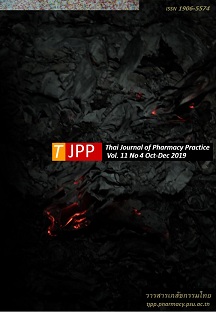การพัฒนารูปแบบการดูแลผู้ป่วยภาวะเหงือกโตจาก การใช้ยาแอมโลดิปีนในผู้ป่วยความดันโลหิตสูง
Main Article Content
บทคัดย่อ
วัตถุประสงค์ : เพื่อกำหนดแนวทางติดตาม เฝ้าระวัง ป้องกัน และจัดการภาวะเหงือกโตหลังการใช้ยา amlodipine วิธีการศึกษา : การศึกษานี้ใช้ระเบียบวิธีวิจัยแบบผสมทั้งเชิงปริมาณและเชิงคุณภาพ ผู้วิจัยเปรียบเทียบผู้ป่วยความดันโลหิตสูงที่ใช้ยา amlodipine (กลุ่มศึกษา) จำนวน 152 คน กับผู้ป่วยความดันโลหิตสูงที่ใช้ยาลดความดันโลหิตชนิดอื่น (กลุ่มเปรียบเทียบ) จำนวน 147 คน การศึกษาประเมินอนามัยช่องปากและเหงือกอักเสบด้วยเกณฑ์การประเมินค่าดัชนีอนามัยช่องปากอย่างง่าย (OHI-S) และประเมินเหงือกโตด้วยเกณฑ์การประเมินของ Bokenkamp และคณะ การประเมินในทั้งสองกลุ่มตัวอย่างทำโดยทันตแพทย์ซึ่งไม่ทราบว่าผู้ป่วยอยู่ในกลุ่มศึกษาหรือกลุ่มเปรียบเทียบ การศึกษาประเมินคุณภาพชีวิตในมิติสุขภาพช่องปากด้วย Oral impact on daily performance (OIDP) ผู้วิจัยพัฒนาแนวทางการดำเนินงานเพื่อเฝ้าระวัง ป้องกัน ติดตาม และจัดการกับภาวะเหงือกโตหลังการใช้ยา amlodipine โดยใช้หลักการ concept mapping ผลการศึกษา : ความชุกของการเกิดเหงือกโตคิดเป็นร้อยละ 12.50 และ 4.76 ในกลุ่มศึกษาและกลุ่มเปรียบเทียบ ตามลำดับ (OR=3.04, 95% CI=1.12-8.20, P=0.018) การสูบบุหรี่ และการเกิดคราบหินปูน มีความสัมพันธ์กับภาวะเหงือกโตอย่างมีนัยสำคัญทางสถิติ รูปแบบการดูแลผู้ป่วยภาวะเหงือกโตจากการใช้ยา amlodipine ในผู้ป่วยความดันโลหิตสูงที่ได้จากการศึกษา ประกอบด้วย 1) การกำหนดนโยบายที่ชัดเจน 2) การสร้างองค์ความรู้ให้กับทีมงาน 3) การมีทีมงานสหวิชาชีพที่เข้มแข็ง 4) การให้บริการเชิงรับที่มีคุณภาพ และ 5) การพัฒนางานเชิงรุกเพื่อป้องกันปัญหา สรุป: ความชุกของการเกิดเหงือกโตจากการใช้ยา amlodipine คือ ร้อยละ 12.50 รูปแบบการดูแลผู้ป่วยภาวะเหงือกโตจากการใช้ยา amlodipine ควรประกอบด้วย 5 ประเด็นที่สำคัญที่พบในงานวิจัย
Article Details
ผลการวิจัยและความคิดเห็นที่ปรากฏในบทความถือเป็นความคิดเห็นและอยู่ในความรับผิดชอบของผู้นิพนธ์ มิใช่ความเห็นหรือความรับผิดชอบของกองบรรณาธิการ หรือคณะเภสัชศาสตร์ มหาวิทยาลัยสงขลานครินทร์ ทั้งนี้ไม่รวมความผิดพลาดอันเกิดจากการพิมพ์ บทความที่ได้รับการเผยแพร่โดยวารสารเภสัชกรรมไทยถือเป็นสิทธิ์ของวารสารฯ
เอกสารอ้างอิง
2. World Health Organization. Promoting rational use of medicines: core components. WHO Policy Perspec- tives on Medicines. Geneva. 2002.
3. Anon. Service plan: Rational drug use (RDU) [online]. 2016 [cited Dec 9, 2016]. Available from: www.hfocus .org/content/2016/07/12427.
4. Muenpa R, Puripunyavanich N. Rational drug use. ) [online]. 2016 [cited Jan 19, 2017]. Available from: ccpe.pharmacycouncil.org/index.php?option=article_detail&subpage=article_detail&id=209
5. Food and Drug Administration. Rational use of drugs: Problems and related factors. Nonthaburi: Ministry of Public Health; 2016.
6. Ministry of Public Health. Service plan: Rational drug use [online]. 2016 [cited Dec 9, 2016]. Available from: www.lpnh.go.th/drug/file/Manual_Service%20Plan%20RDU_Sept2016.pdf.
7. Sanjeev J, Sucheta B. A rare case report of amlodipine-induced gingival enlargement and review of its pathogenesis. Case Rep Dent. 2013; 2013:138248. doi: 10.1155/2013/138248.
8. Aldemir NM, Begenik H, Emre H, Erdur FM, Soyoral Y. Amlodipine-induced gingival hyperplasia in chronic renal failure: a case report. Afr Health Sci. 2012; 12: 576-8.
9. Madi M, Shetty SR, Babu SG, Achalli S. Amlodipine-induced gingival hyperplasia–A case report and review. West Indian Med J. 2015;64:279.
10. Livada R, Shiloah J. Calcium channel blocker-induced gingival enlargement. J Hum Hypertens. 2014; 28:10-4.
11. Katzung BG. Vasodilator and the treatment of angina pectoris. In: Katzung BG , Masters SB, Trevor AJ, editors. Basic and clinical pharmacology. 12th ed. New York: The McGraw-Hill; 2007. p. 193-210.
12. Golan DE, Tashjian AH. Principle of cardiovascular pharmacology. In: Williams L, Wilkin L, editors. Principle of pharmacology. New York; 2008. p. 368-70, 377-9.
13. Armitage GC. Development of a classification system for periodontal diseases and conditions. Ann Periodon tol. 1999;4:1-6.
14. The American Academy of Periodontology. Glossary of Periodontal Terms. 4th ed. Chicago: The American Academy of Periodontology; 2001.
15. Srivastava AK, Kundu D, Bandyopadhyay P, Pal AK. Management of amlodipine-induced gingival enlarge ment: Series of three cases. J Indian Soc Periodontol. 2010; 14: 279–81.
16. Hassell TM, Hefti AF. Drug-induced gingival over growth: old problem, new problem. Crit Rev Oral Biol Med 1991;2:103-37.
17. Mishra MB, Khan ZY, Mishra S. Gingival overgrowth and drug association. J Acad Med Sci. 2012.2; 91-6.
18. Gosavi DD, Nanotkar S, Suman A. Drug induced gingival enlargement. Int J Pharmaceut Appl. 2013; 4: 43-8.
19. Brown RS, Arany PR. Mechanism of drug-induced gingival overgrowth revisited: a unifying hypothesis. Oral Dis. 2015; 21: e51–e61.
20. Health Product Vigilance Center. Spontaneous report of adverse drug reaction 2008. Nonthaburi. Food and Drug Administration, Ministry of Public Health, 2008: p. 51-4.
21. Health Product Vigilance Center. Spontaneous report of adverse drug reaction 2010. Nonthaburi. Food and Drug Administration, Ministry of Public Health, 2010: p. 98-107.
22. Health Product Vigilance Center. Spontaneous report of adverse drug reaction 2011. Nonthaburi. Food and Drug Administration, Ministry of Public Health, 2011: p. 76.
23. Health Product Vigilance Center. Spontaneous report of adverse drug reaction 2012. Nonthaburi. Food and Drug Administration, Ministry of Public Health, 2014: p. 115.
24. Health Product Vigilance Center. Spontaneous report of adverse drug reaction 2013. Nonthaburi. Food and Drug Administration, Ministry of Public Health, 2014: p. 85-6.
25. Health Product Vigilance Center. Spontaneous report of adverse drug reaction 2014. Nonthaburi. Food and Drug Administration, Ministry of Public Health, 2014: p. 91-2.
26. Health Product Vigilance Center. Spontaneous report of adverse drug reaction 2015. Nonthaburi. Food and Drug Administration, Ministry of Public Health, 2016: p. 108-9.
27. Health Product Vigilance Center. Spontaneous report of adverse drug reaction 2016. Nonthaburi. Food and Drug Administration, Ministry of Public Health, 2017: p. 120.
28. Armitage GC. Development of a classification system for periodontal diseases and conditions. Ann Periodon tol 1999;4:1-6.
29. Jorgensen MG. Prevalence of amlodipine-related gingival hyperplasia. J Periodontol 1997;68: 676-8.
30. Ellis JS, Seymour RA, Steele JG, Robertson P, Butler TJ, Thomason JM. Prevalence of gingival overgrowth induced by calcium channel blockers: A community-based study. J Periodontol 1999; 70:63-7.
31. Ono M, Tanaka S, Takeuchi R, Matsumoto H, Okada H, Yamamoto H, et al. Prevalence of amlodipine-induced gingival overgrowth. Int J Oral-Med Sci 2010; 9: 96-100.
32. Karnik R, Bhat KM, Bhat GS. Prevalence of gingival overgrowth among elderly patients under amlodipine therapy at a large Indian teaching hospital. J Gero dontol 2012; 29: 209-13.
33. Livada R, Shiloah J. REVIEW Calcium channel blocker-induced gingival enlargement. J Hum Hyper tens 2014;28,10–4.
34. Jose J, Santhosh YL, Naveen MR, Kumar V. Case report of amlodipine induced gingival hyperplasia late onset at a low dose. Asian J Pharm Clin Res. 2011; 4: 5–6.
35. Wisetsing C, Niwatananun K, Ruengorn C. Preva lence of gingival enlargement and associated with amlodipine. Thai Pharmaceutical and Health Science Journal. 2014; 9: 17-25.
36. Bokenkamp A, Bohnhorst B, Beier C, Albers N, Offner G, Brodehl J. Pediatric nephrology. Pediatr Nephro. 1994;8:181–5.
37. Wei SH, Lang NP. Periodontal epidemiological indices for children and adolescents: II. Evaluation of oral hygiene; III. Clinical applications. Pediatr Dent. 1982; 4: 64–73.
38. Greene JC, Vermillion JR. The simplified oral hygiene index. J Dent Assoc. 1964;68:7–13.
39. Adulyanon S, Sheiham A. Oral Impacts on Daily Performances. In: Slade GD, editor. Measuring oral health and quality of life. North Carolina: Chapel Hill; 1997. p. 151-60.


